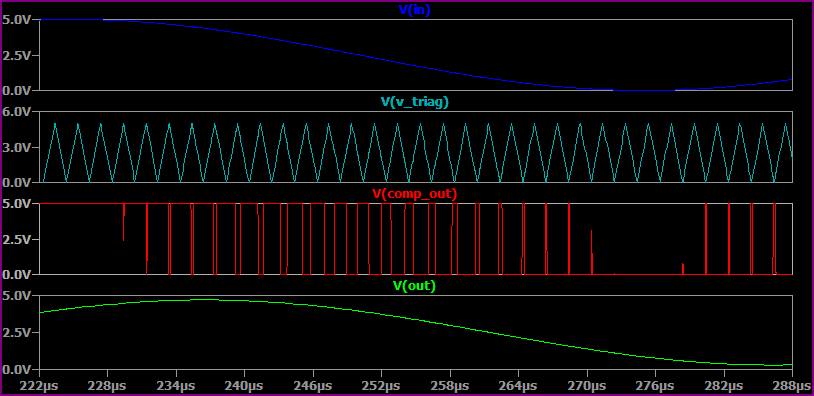I have recently heard of the concept of a one-bit ADC, and have seen it implemented in the context of a sort of digital-to-analog converter (oddly enough), and I'm wondering, what is the point? Why not simply use a higher-resolution ADC, if higher resolution is desired?
4 Answers
To give a basic example of how a 1-bit ADC can be used to obtain useful information from a waveform, take a look at this circuit. It uses a triangle wave to turn the information into a pulse width modulated output. This is a similar but simplified version of how other 1-bit ADC techniques work, by using a (usually fedback) reference signal to compare the input to.
Circuit

Simulation

Magnified Timescale View:

We can see from the top input waveform, the triangle wave is used to compare the waveform at different points through it's period. As long as the triangle wave is of a considerably higher frequency than the input (the higher the frequency the more accurate), this causes the comparator to output an average of high/low depending on the voltage level of the waveform.
To see how we can reproduce the original waveform from the PWM data, the comparator output is fed into a low pass filter, and out pops the sine wave again.
For further reading:
Delta-Sigma Converters
Successive Approximation ADC
Single Bit ADCs
Ramp Compare ADC (Counter ADC)
A one-bit analog to digital converter (A/D) is just a comparator with the threshold in the middle of the range. Usually you don't call it a 1-bit A/D though, although it is legitimate to think of it that way.
There are ways to make use of a comparator to ultimately get a higher resolution digital value. A delta-sigma A/D is one example. This keeps integrating the comparator output and comparing it back to the analog input. Over a number of bit times, the analog value is represented by the number of 1 bits out of the whole. Resolution is a tradeoff with time. Nowadays the bit rate can be in the multiple MHz range. For example, at 10 MHz bit rate, getting a 20 bit result (about 1 M counts) would take 1/10 second.
Another example is a "tracking" A/D. This contains a D/A and the comparator compares the D/A result with the analog input. If the comparator result is low, the D/A value is incremented, otherwise it is decremented.
-
\$\begingroup\$ Delta sigma can also be viewed as an analog to PWM modulator. \$\endgroup\$– jippieCommented Feb 27, 2013 at 20:15
-
\$\begingroup\$ How about linearity Olin? How does Delta-Sigma compare to various non-linearities of a regular n-bit ADC? \$\endgroup\$– jippieCommented Feb 27, 2013 at 20:16
-
\$\begingroup\$ @jipp: Yeah, a delta-sigma A/D is backwards PWM. The PWM generator is in the feedback path, so overall you find the duty cycle value to get the average level. \$\endgroup\$ Commented Feb 27, 2013 at 20:18
-
\$\begingroup\$ With second-order sigma delta you need far fewer bits (~ the square root), via some signal processing noise shaping magic that I don't fully understand. \$\endgroup\$– starblueCommented Feb 27, 2013 at 20:27
One difference not yet mentioned between the terms "1-bit ADC" and "comparator" is that in many places where comparators are used, it is desirable to have hysteresis in an amount which is greater than the system's baseline noise level, but in applications that use a 1-bit ADC, such hysteresis is not wanted.
When constructing a multi-bit DAC or ADC, it is often difficult to ensure that each bit will have an effect precisely twice as big as the next lower one. If the effect of a bit is larger or smaller than this, the difference in the voltages represented by between a code which ends in e.g. "0111" and the next higher code (which ends in 1000") will be incorrect. If e.g. a 1mV change on an input sometimes causes a reported ADC value to change by 2 and sometimes causes it to change by 6, that can cause differential-feedback-based control systems to over-react to some changes and under-react to others.
Using a 1-bit ADC along with some analog electronics, it's possible to design a circuit so that the percentage of time a signal is high will depend upon the ratio between an input voltage and a reference voltage. If one measures the percentage of time the signal is high, one may thus infer the input voltage. In the absence of hysteresis or related effects, this measurement may be very accurate. Hysteresis, however, may cause non-linearities which may be difficult to correct for.
Another name for a one bit ADC is a comparator. I can imagine 1 bit ADC may be enough for an application which needs to turn on/off a valve, switch, alarm if the signal goes above/below a threshold.
-
1\$\begingroup\$ Definitely correct, but I think what I saw referred to as a "1-bit ADC" was more accurately described as a "delta-sigma ADC". \$\endgroup\$– MarkCommented Feb 27, 2013 at 20:56
